In this article, we’re going to talk about Rank Math Bulk and Quick Editing Options. One of the most frustrating parts of optimizing posts and pages on your website is that there is no easy to make edits to multiple posts. Even if the features exist, there is no way to filter or select the exact posts you want to make changes on. These problems keep growing as your website keeps growing, and the only solution is to work it out manually with elbow greaseless than ideal.
With Rank Math, we wanted to eliminate this problem entirely. That is why we created some amazing filtering options inside Rank Math, which will make your life much easier. Let us explore these features one by one.
Rank Math vs. Rank Math Pro
Rank Math is free to use, now and forever. For professionals and people who want to make serious SEO progress on their website, we introduced Rank Math Pro. Some of the features we are going to talk about will be available in the free version of Rank Math, while some are reserved for Rank Math Pro. We will highlight those features prominently while we’re discussing them.
Rank Math Bulk and Quick Editing
Filtering
As we mentioned, one of the key challenges in optimizing a lot of posts for SEO is filtering the right posts. With Rank Math, that problem is no more as we’ve introduced amazingly powerful filtering options. You can find these options inside your All Posts page.

From the surface, they may look like simple filtering options that you see inside of WordPress. But under the surface, Rank Math has supercharged them with some amazing options. Let us show you the filtering options first; then, we’ll show you the bulk actions.

Date Filtering
The date filtering is the same that you’d find inside WordPress, and Rank Math does not change them. Using the date filtering, you’ll be able to filter your posts or pages by the month they were published in.

Category Filtering
The category filter is also straightforward, and Rank Math does not change it in any way. Using the category filter, you will be able to filter the posts based on the categories on your website.

Post Type Filter
This is the option where Rank Math works its magic. You can combine the date and category filtering options with the new filtering options in this option to drastically improve your workflow. Let us show you the options available.
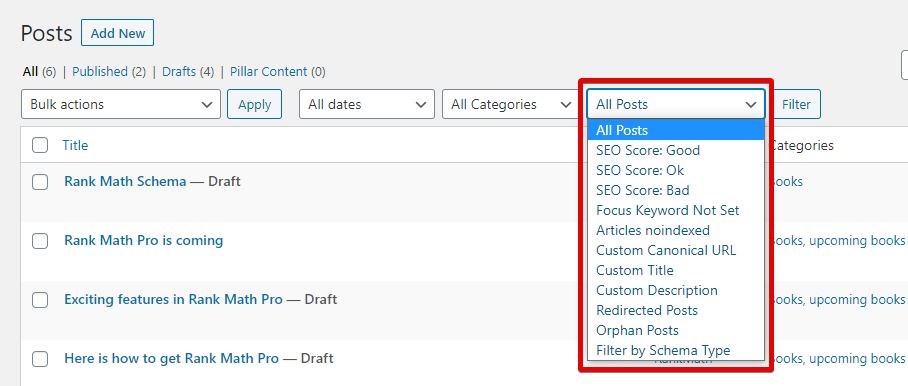
As you can, these are some amazing filtering options. Let us tell you what each of these options lets you achieve.
SEO Score: Good
This option lets you filter only those posts on your website that have a Good SEO score with Rank Math. All you have to do is select the filter, then click the Filter button.

And Rank Math will find all the posts with the Good SEO score.

SEO Score: OK
This filter option lets you filter the posts that have the OK SEO score assigned by Rank Math. Just select the filter, then click the Filter button.
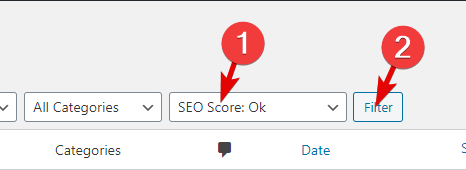
And Rank Math will filter out the posts which have the OK SEO score.
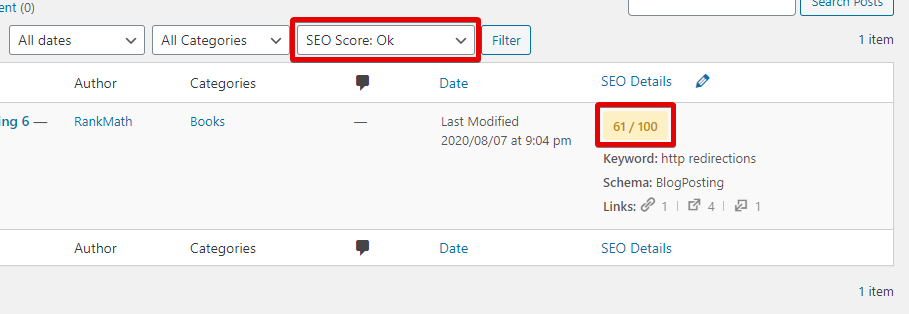
SEO Score: Bad
This option lets you filter only those posts that have a Bad SEO rating from Rank Math. To use the filter, select the option from the drop-down menu and then click the Filter button.
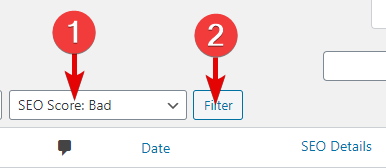
Rank Math will bring forth only those posts forward, which have a Bad SEO rating, similar to the example below.

Focus Keyword Not Set
This filter lets you find all the posts or pages on your website that don’t have a focus keyword set. As you can imagine, this feature is amazing for new websites, or websites with a lot of content who have just started to optimize their posts properly.
To use the filter, just select the option from the drop-down menu and click the Filter button.
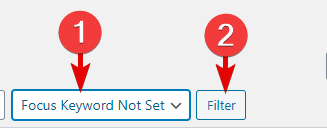
Rank Math will find and display all the posts on your website that don’t have a focus keyword set. Later in this article, we will also show you how you can utilize this feature to quickly add focus keywords to a lot of posts.
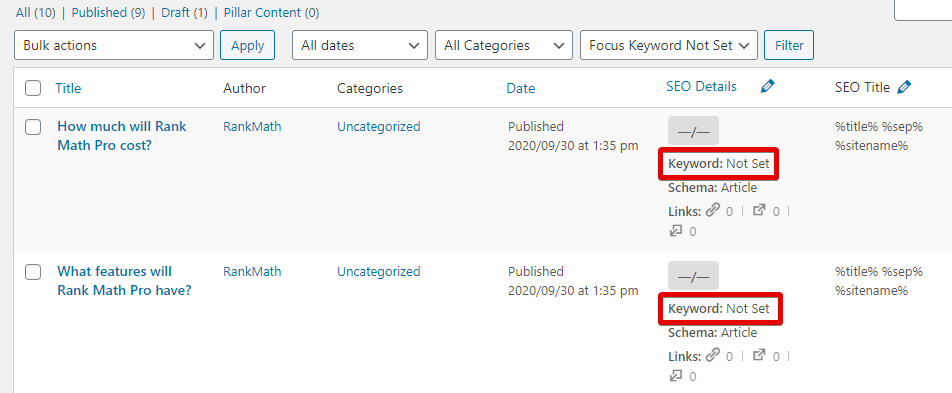
Article Noindexed
This filter helps you find all the posts or pages on your website that are set to noindex. Many times, you can set these up accidentally when setting up the Global SEO Meta. This filter quickly lets you find the posts and correct them. Even if you made no errors, this filter lets you quickly check that only the intended posts are being noindexed.
To use the filter, select the option from the drop-down menu, and click the Filter button.
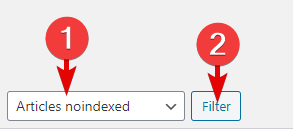
Rank Math will then return a list of posts that are noindexed.

- Rank Math General Settings In 3 Easy Steps
- Rank Math Import And Export Settings In 5 Easy Steps
- Rank Math Sitemap Issues and Their Fixes
- Rank Math Titles And Meta Settings In 5 Easy Steps
Custom Canonical URL (Pro)
A canonical URL is an important tool in any webmaster’s toolkit. It is a property that helps search engines know the original source of a webs page. For example, If you have a post on your website which appears in more than one category, then you might have URLs like these:
https://yourwebsite.com/cateogry-1/post https://yourwebsite.com/category-2/post
In both these cases, the post would be the same. But, to Google, different URLs mean different posts.
Rank Math automatically adds a canonical URL to all your posts to avoid this issue. You can find the option inside Rank Math options under the Advanced Tab.
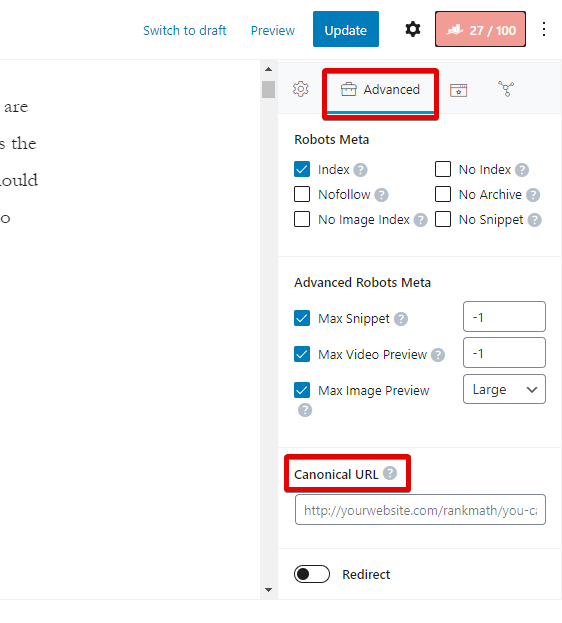
As you can also see in the image, Rank Math has set up a canonical URL that is displayed as a placeholder. You still have the option of going in and changing the URL.
And that is what this filter is designed for. It helps you quickly filter the posts that have a custom canonical URL set. To use this filter, select the option from the drop-down menu and click the Filter button.
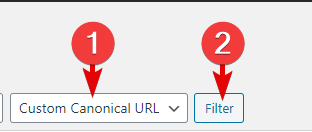
And Rank Math will filter and present the posts that have a custom canonical URL set.
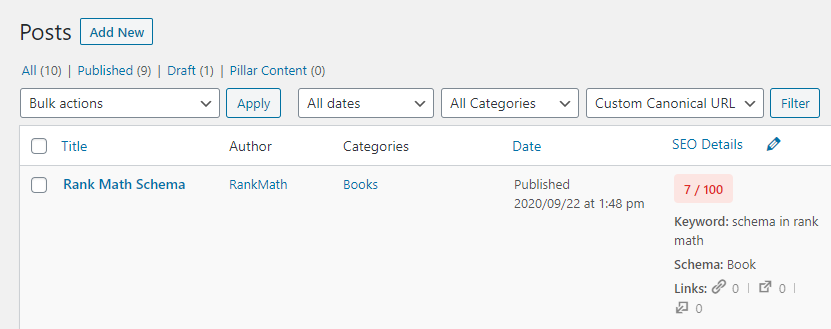
Custom Meta Title (Pro)
Rank Math helps you set the optimal titles for your posts by letting you set a global SEO title for your posts. These settings can be found in Rank Math > Title and Meta > Posts.
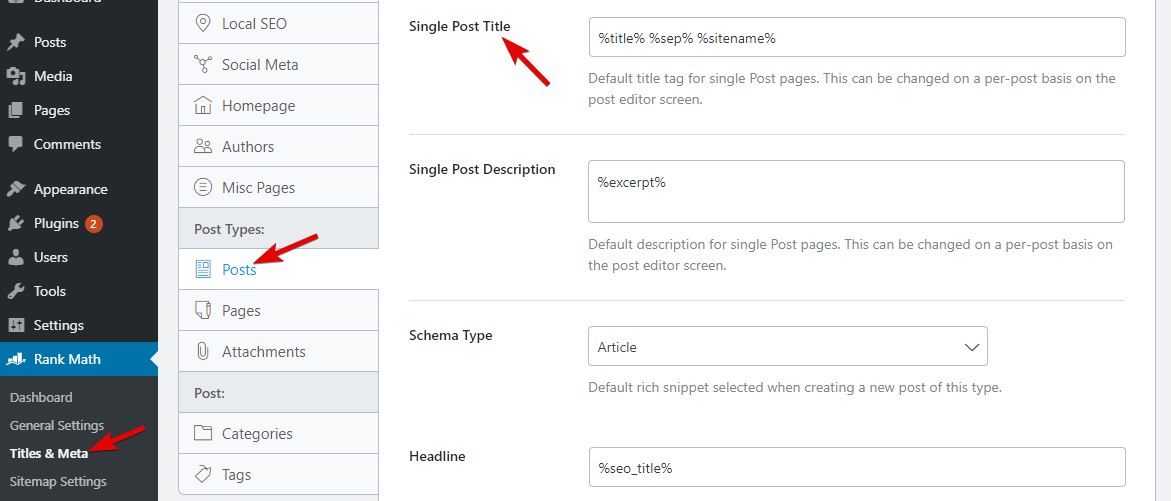
With the help of variables, you can setup optimized meta-titles for your posts, pages, and even custom posts easily. All the posts on your website inherit these options, and Rank Math then replaces the variables with their actual values, creating optimized meta-titles for your posts.
Of course, you have the option of customizing the meta-title for every post on your website as well. You will find that option on your post inside Rank Math’s General Tab by clicking the Edit Snippet button.
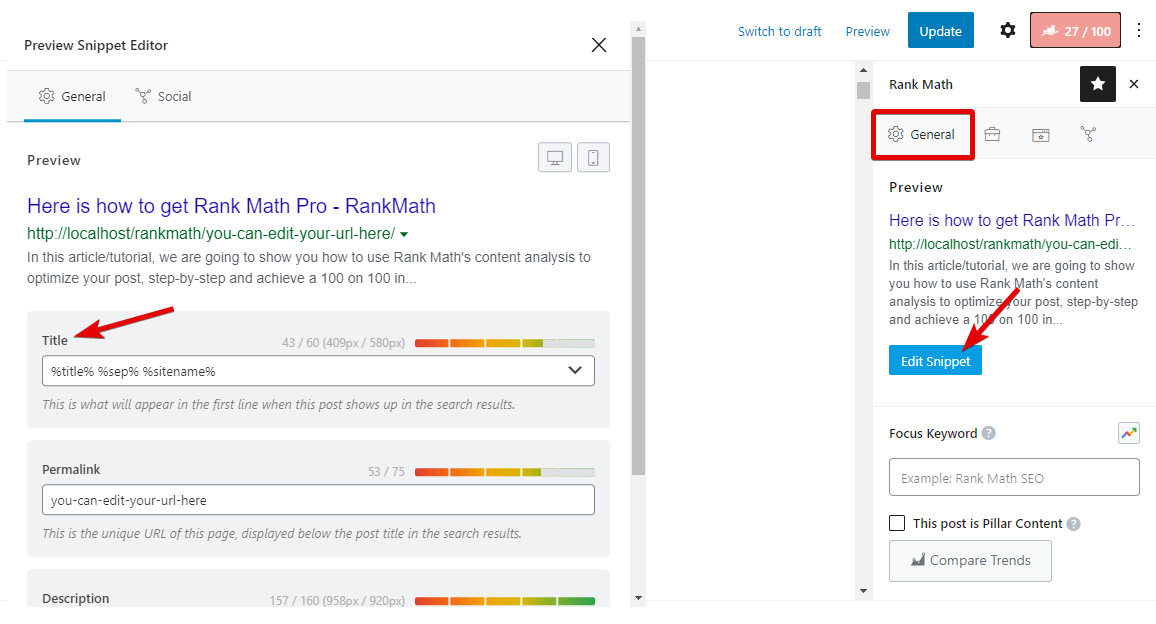
This filter in Rank Math lets you filter all the posts, pages, or custom posts that have a custom meta title set. Please note that this filter will filter the posts with a custom meta title, not a regular title. In fact, the regular post titles are always custom, as they are created by you.
To use this filter, select it from the drop-down menu, and click the Filter button.
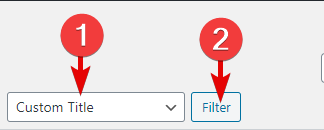
Rank Math will quickly find and display the posts with custom meta titles.

Custom Meta Description (Pro)
Rank Math lets you define global meta descriptions that are inherited by your posts, pages, and custom posts. You can find the configuration options inside Rank Math > Titles and Meta > Posts.
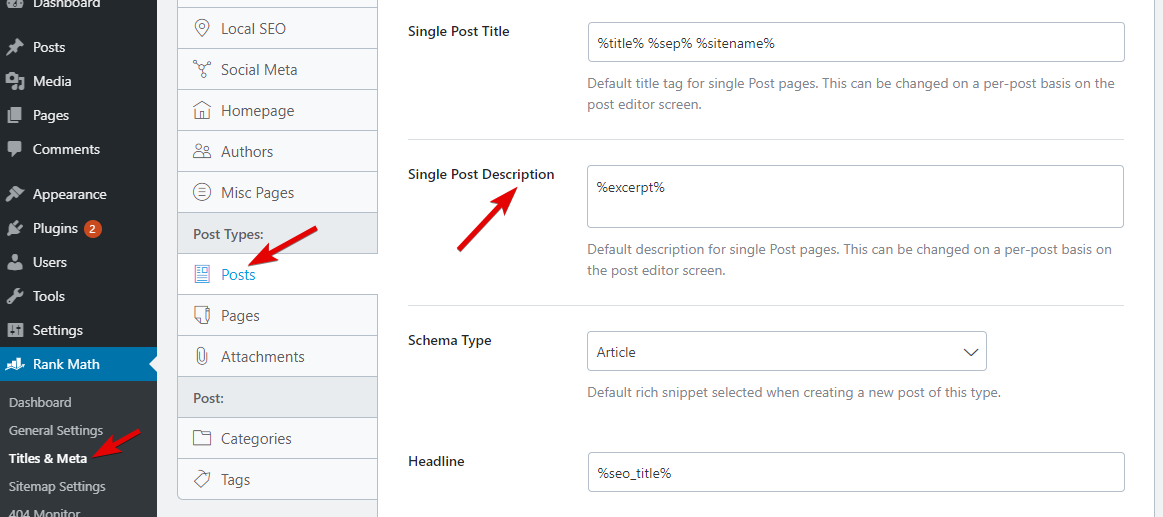
Here, you can use variables to create optimized meta-descriptions for your posts or pages, which are then used throughout your website. Of course, you can still use custom meta-descriptions on your website by navigating to the post and opening Rank Math’s General Tab. Inside the description setting, you can customize the meta-description using variables or static text.
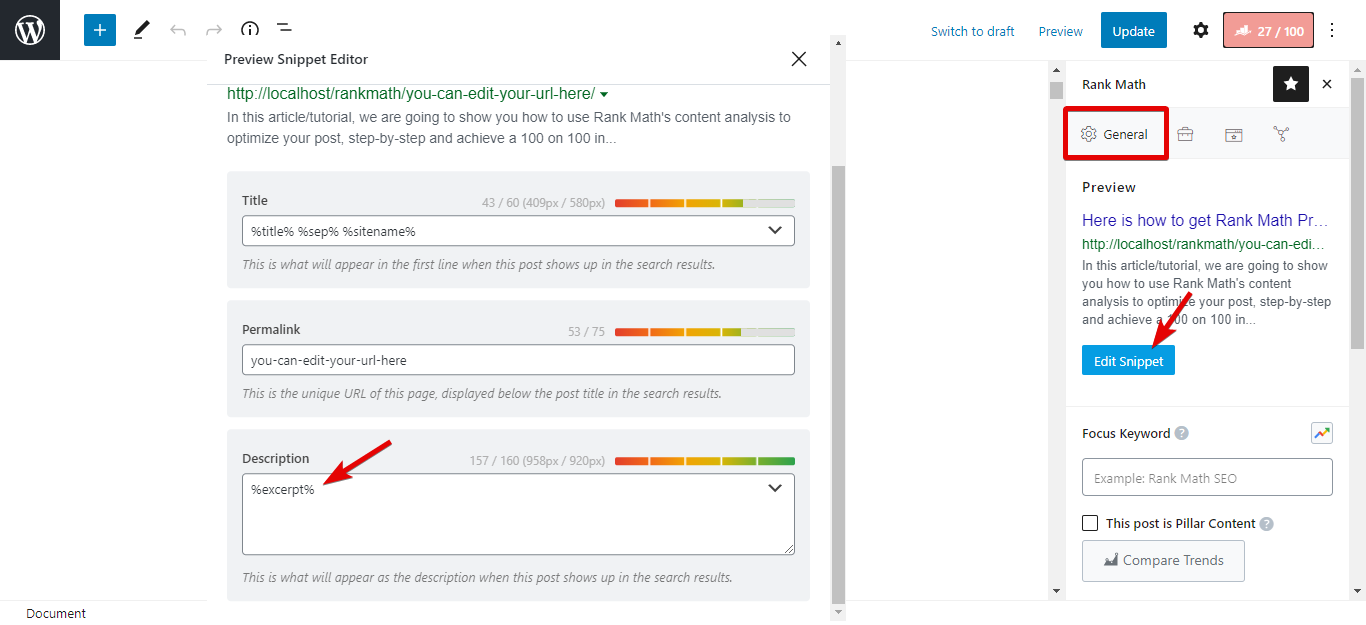
The Custom Description Filter will help you find the posts that have a custom description set. In other words, you can find the posts that are not using the global meta description settings.
To use the filter, select it from the drop-down menu and click the Filter button.
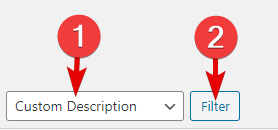
Rank Math will go to work and find the posts that have a custom description set.

Note: It is important to know and remember that this filter will find and filter the posts that have a custom meta-description, not the regular post description.
Redirected Posts (Pro)
Rank Math has a sophisticated redirection manager using which you can create and manage redirects on your website. You can find the redirection manager inside the Rank Math menu.
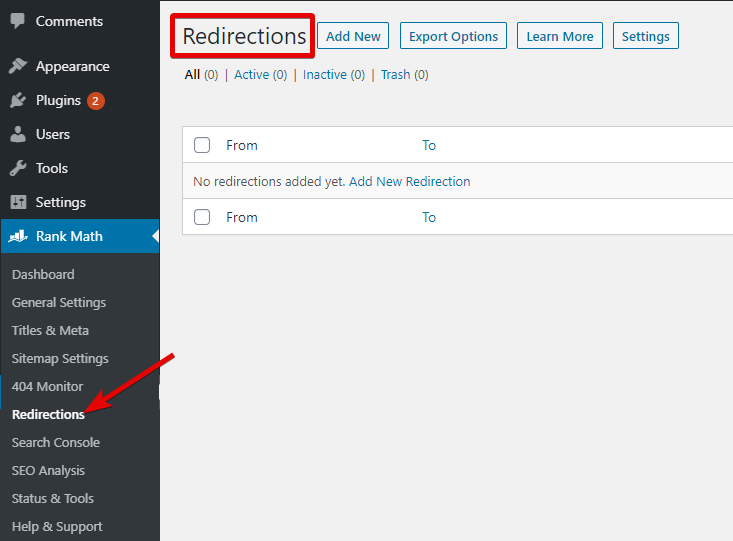
And, you can redirect posts quickly using the redirect option present on each post. You can find it under the Advanced Tab in Rank Math.
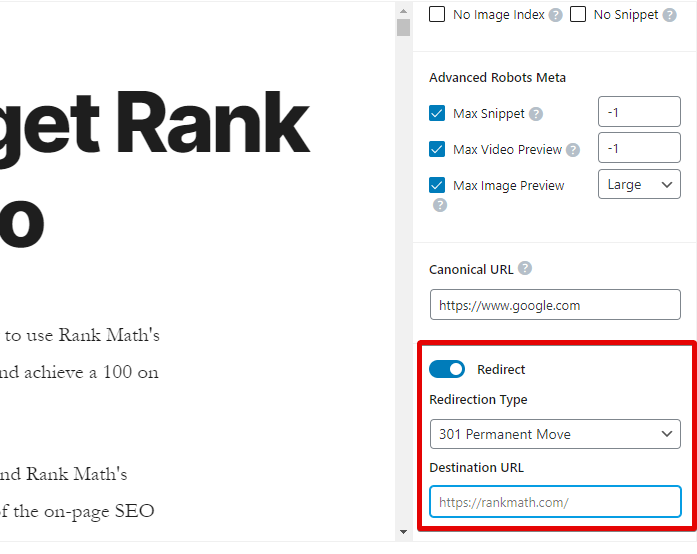
Redirects can be made for many reasons, but the important thing is to know which pages are redirected. What if you create a new post and change the redirect from old posts to the new one?
That is where this filter comes in. This filter will help you find the posts that are redirected to a different post. To use it, simply select the filter from the drop-down menu, and click the Filter button.

Rank Math will quickly find all the posts, pages, or custom posts (wherever you use the filter) that have a redirect set.

Orphan Posts (Pro)
It is no secret that links form the basis of the web, and search engines also use to navigate and index your website. That is why it is recommended that you add internal links from your posts to other posts so that they can be discovered, and link juice may also pass between them.
However, when you’re dealing with a lot of content, lapses happen. Sometimes you forget to add them, or sometimes you might not have been aware of how important this is. Both scenarios result in orphan pages.
Orphan pages are the pages that don’t have any incoming internal links to them. If you map out your website architecture, they will be floating in space.
Orphan pages are not good for SEO, that’s obvious. But, what many people don’t realize that they are also low hanging fruit for SEO wins. Just add simple links, and you have more traffic coming to them, right?
Technically, the answer is yes. But, the bigger challenge is finding orphan pages and quickly fixing them. In fact, Rank Math has a handy indicator that lets you know the exact number of incoming links a page has, but even that doesn’t help much when you’re dealing with a large number of pages.

That is where the value of this filter comes in. When you use this filter, Rank Math will quickly display all the posts, pages, and custom posts on your website that have no incoming links. In other words, you can filter orphaned pages. To use it, just select the filter and click the Filter button.
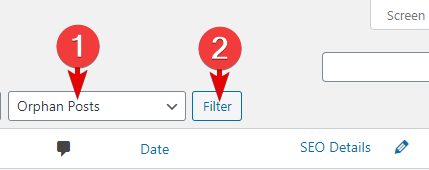
In just a few seconds, Rank Math will display only orphaned posts on the screen.
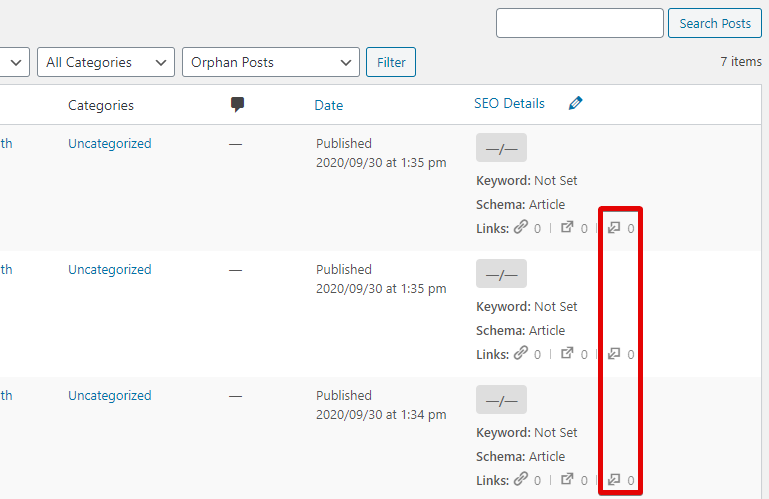
Filter by Schema Type (Pro)
Rank Math has beautiful support for Schema structured data. Not only can you set the default schema type that is added to posts, pages, and custom posts, you can also customize the schema data that appears on every post.
With Rank Math Pro, you can take that further by using schema templates, advanced rules for displaying schema, and even adding multiple types of schema on a single post type.
With this filter, you can quickly see all your posts that are using a particular type of schema. When you select this filter, you’ll see another menu appear by its side.
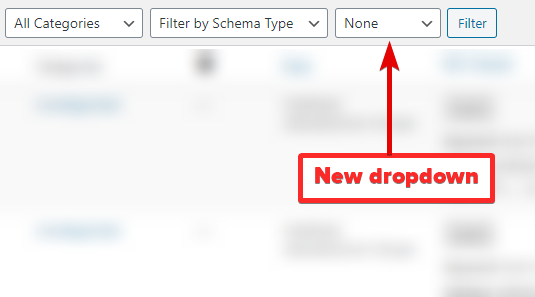
And that menu contains a list of all the schema types supported by Rank Math.
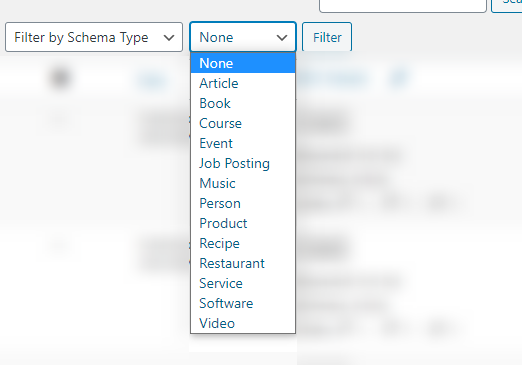
So, to use this filter, all you have to do is select the schema type you want to see posts for and click the Filter button.

And Rank Math will display only the posts with the particular schema type.

How to Use the Filtering Options
Now that you have seen the power of the filtering options, you might be wondering, how would you utilize them? That’s understandable, as we haven’t explained the process of utilizing the filtering options and making changes to your posts. Without the second part, the first part isn’t very powerful.
So, once you start using the filtering options, you will need to use either the Bulk Actions or Quick Actions to make changes to your posts quickly. Let us explore both options one by one.
Bulk Actions
Bulk Actions have been present in WordPress for years. They are useful, but they are not groundbreaking in any way. But, with Rank Math’s help, bulk actions get the needed shot in the arm and become armed with some amazing options. Here are all the options that you will see in the bulk edit options.
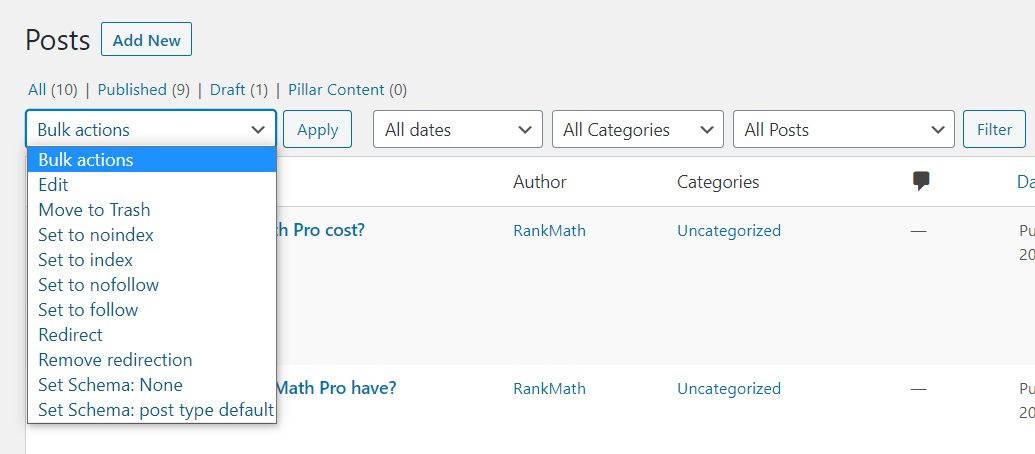
If you’ve been paying attention, maybe the dots are connecting in your head. When you combine the filtering options with the powerful bulk actions, you can get some amazing things done on your website in just a few clicks.
Let us go through each of the options and explain what they can do.
Edit
The edit option is present in WordPress by default as well, but it exists without the powerful filtering options in Rank Math Pro. When you use the edit option, you can edit some properties or content of your posts, pages, or custom posts at the same time. To use the action, either use the filtering option to filter some posts, or select some posts by hand. Then choose the Edit option and click the Apply button next to it.
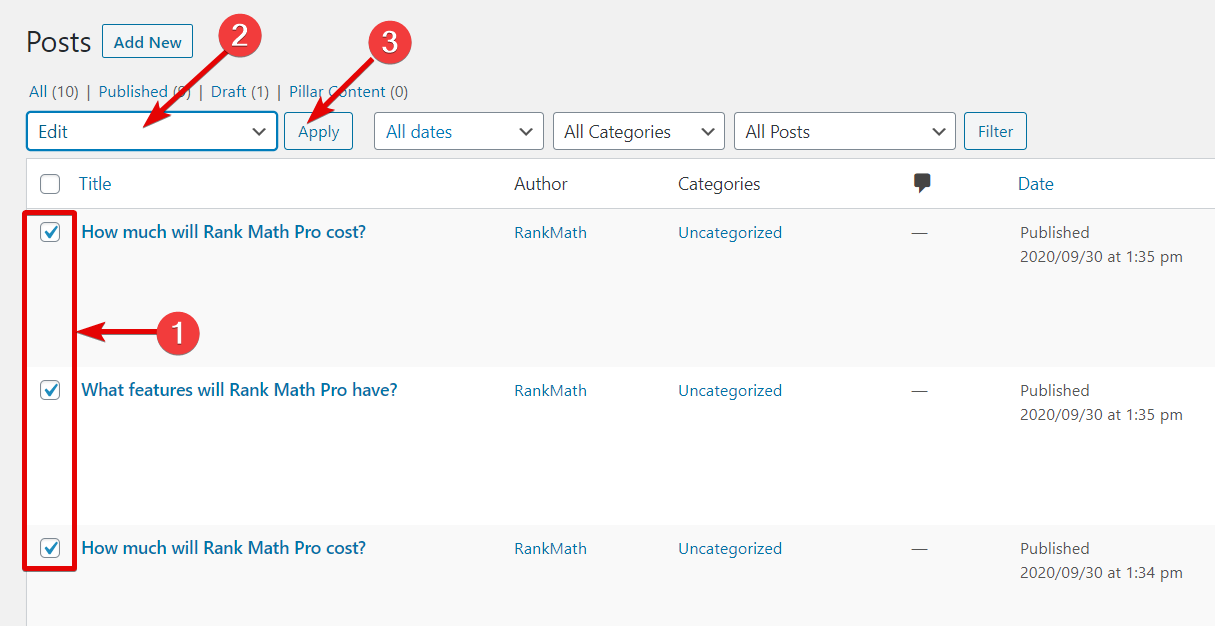
And this is the interface you will see.
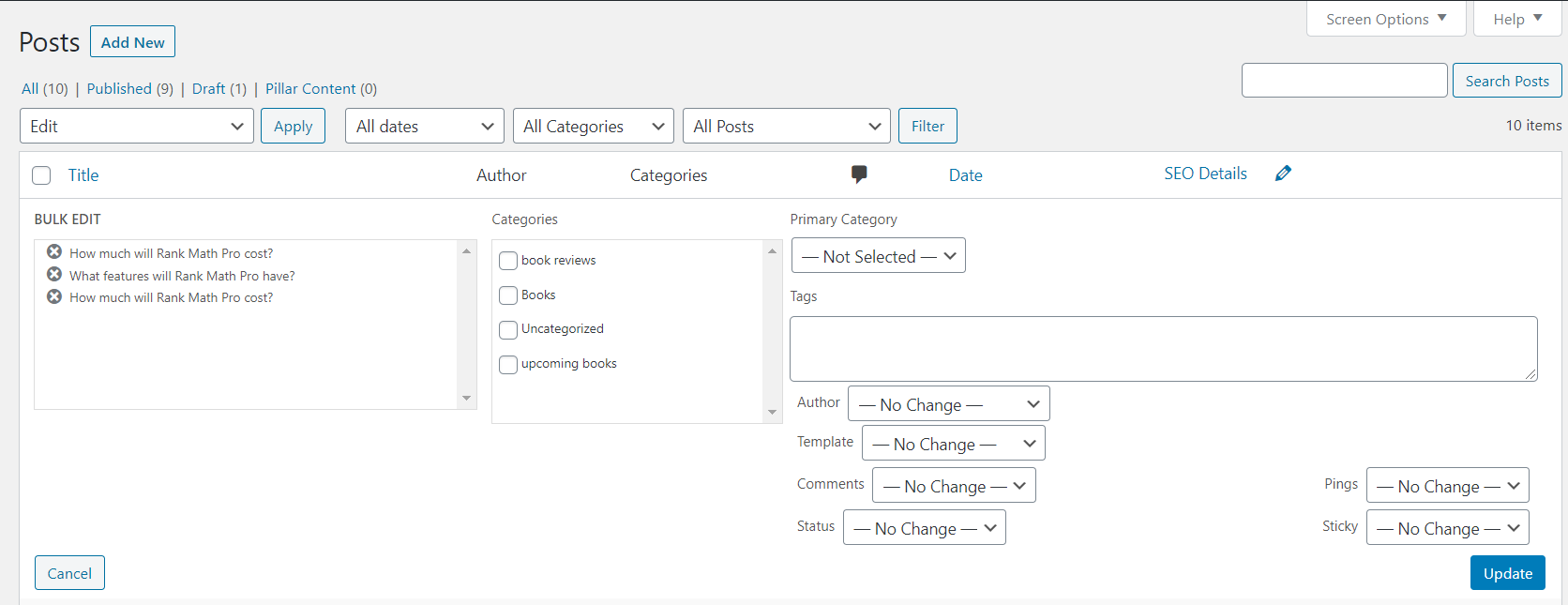
As you can see, you do the following actions to the selected posts.
- Add or remove categories
- Choose a primary category
- Add, modify, or remove tags
- Assign an author
- Assign a default template
- Enable or disable templates
- Change the status of the posts
- Enable or disable pingbacks
- Make the posts sticky or not sticky
Another important thing you can do is remove any of the posts from the filtered list and apply the bulk actions to the rest. This is tremendously helpful as many times, the filters are not enough. This way, you can select more posts than needed, then delete the ones that you don’t want to edit from the list.
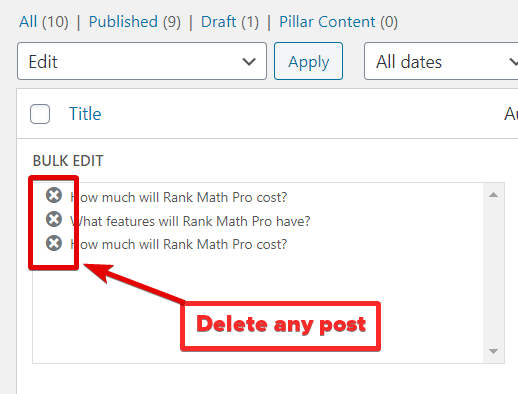
Move To Trash
This is another core WordPress bulk actions. This one is pretty simple. It sends all the selected posts to the trash. To use it, select the action from the bulk actions menu and click the Apply button next to the option.
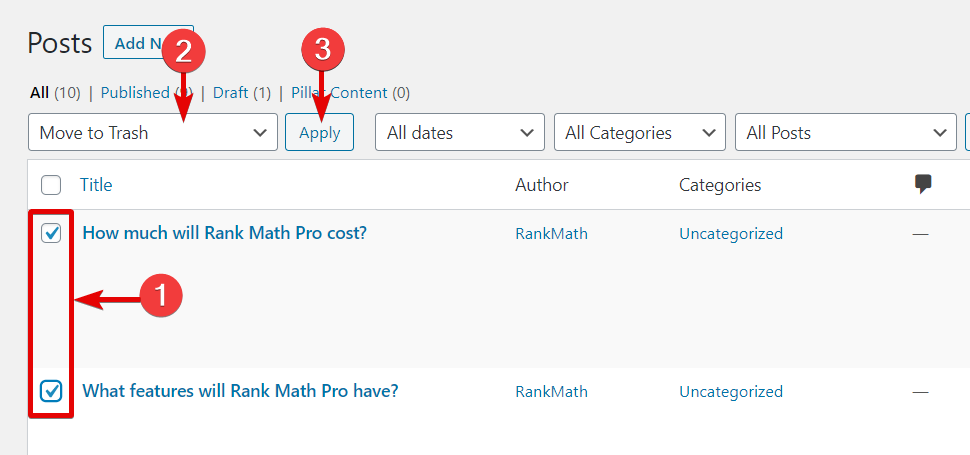
The selected posts will be moved to the Trash. From there, you can restore them or delete them permanently.
Set to Noindex (Pro)
Rank Math gives you the option of configuring Global Meta for your website, which can then be customized for posts, pages, and custom posts. You will find these options in Rank Math Menu > Titles and Meta.
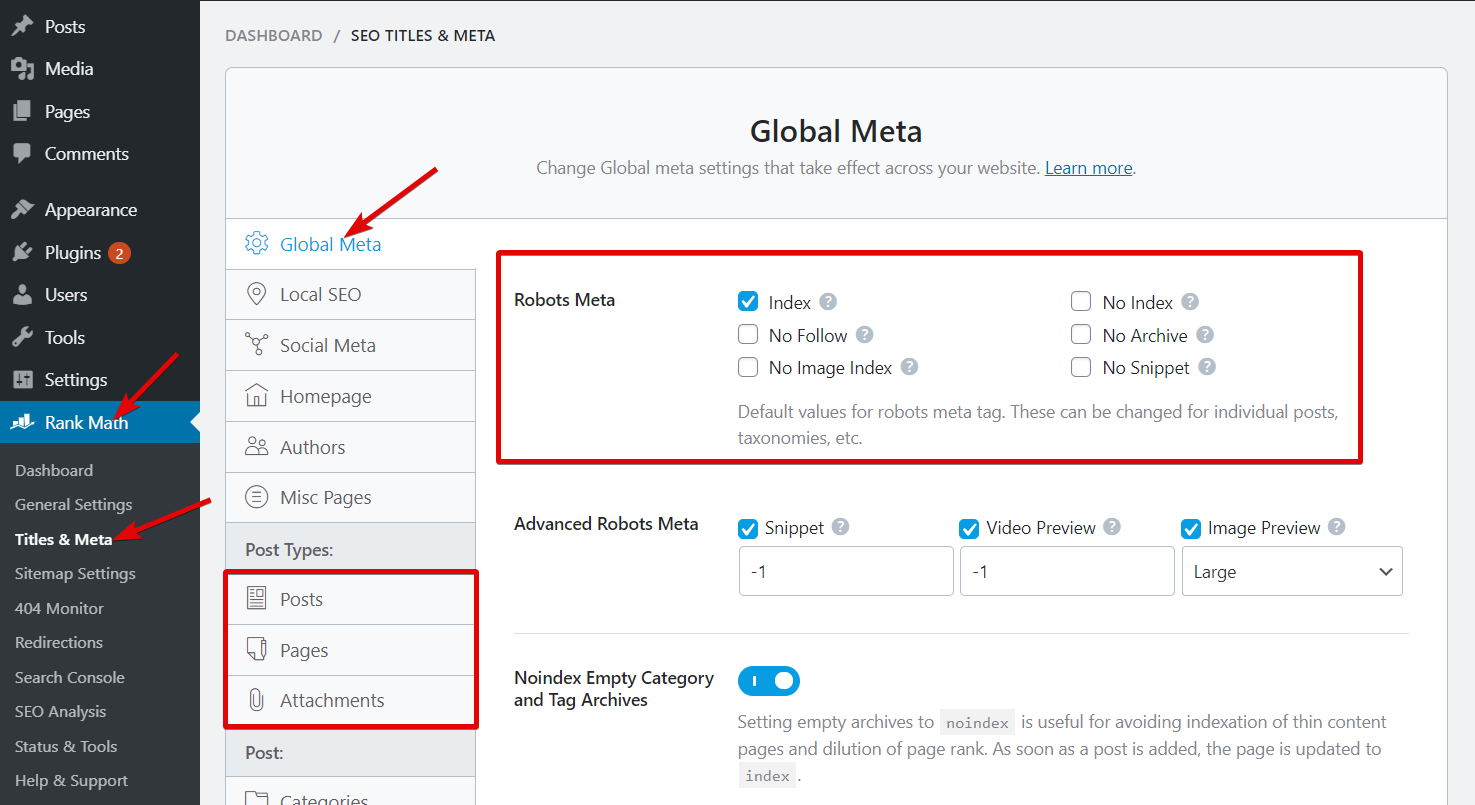
This bulk action lets you change the robots meta applied to posts. Specifically, you can set multiple posts, pages, or custom posts to noindex, which means search engines won’t index those specific posts.
To use this bulk action, filter and select the posts you want to set to no-index. Then select the bulk action and click the Apply button next to it.
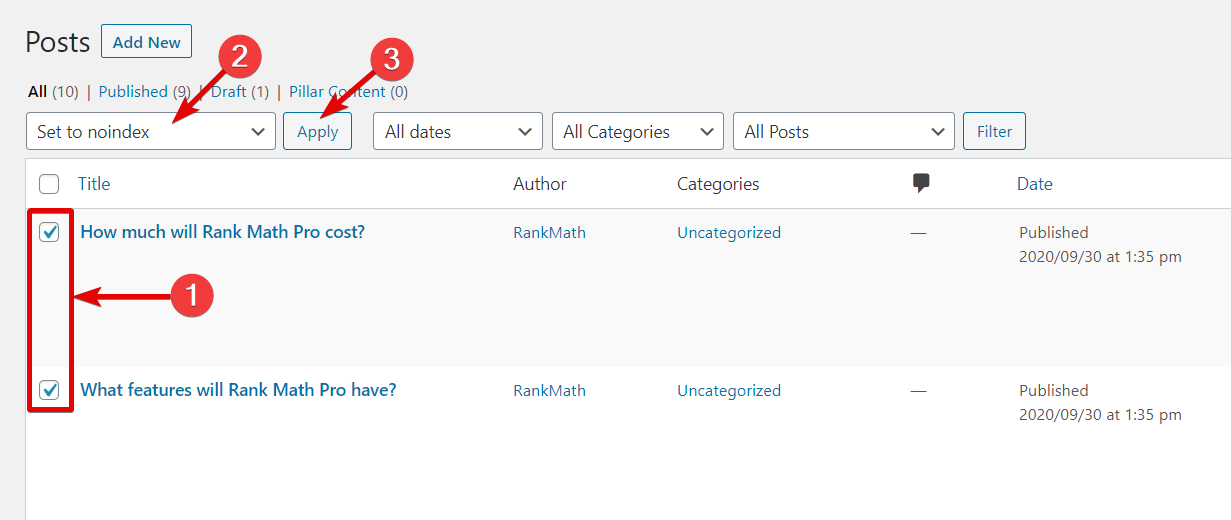
The page will refresh, and you will a confirmation notice on the top of the screen. You will also be able to see the post’s status directly in the posts view.

Set to Index (Pro)
This bulk action works in the complete opposite way of the one we discussed above. This bulk action helps you set multiple posts to index, which means that search engines will be able to index the content.
The process to use the bulk action is the same. Select the posts you want to set to index, select the bulk action, then click the Apply button. Let us use the same posts that we used in the example above for this example as well.

As expected, we saw a success notice appear on the screen, and the posts were once again set to index.
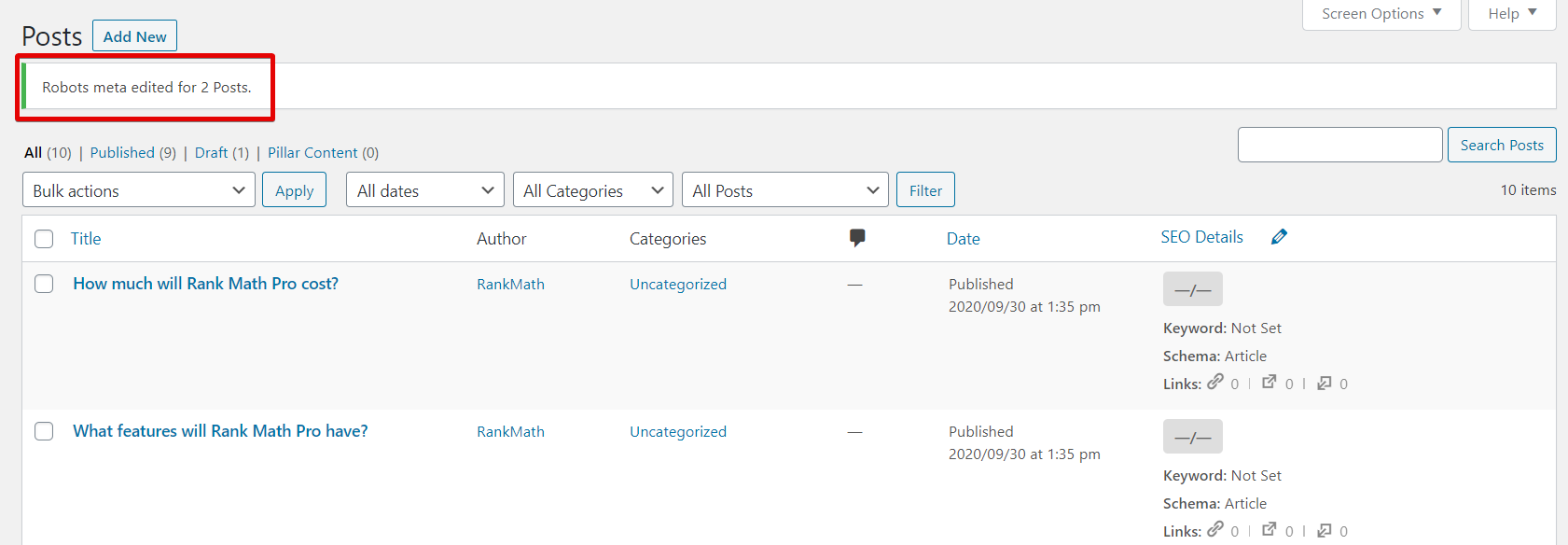
Set to Nofollow (Pro)
No-follow is another robots-meta that you can set with the global meta options in Rank Math. When a post is set to nofollow, then search engines index the post, but do not follow the links from the page. By using this bulk action, you can set all the selected posts, pages, and custom posts to nofollow instantly.
To use this bulk action, manually select the posts you want to apply the actions to, or use the filtering option to filter your posts then select them. Once selected, use the drop-down menu to select the action, then click the Apply button.
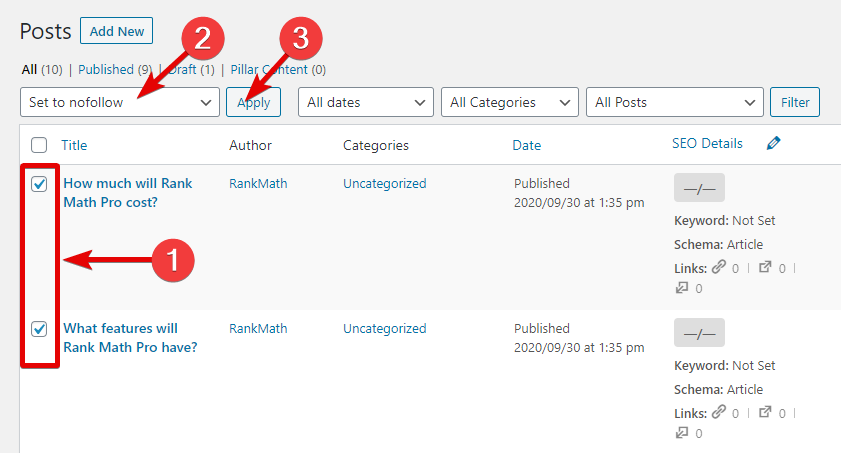
You’ll see a confirmation message on the screen, which will include the number of posts that were affected.

Set to Follow (Pro)
This bulk action works in the opposite way to the action above. When used on posts, this action will all those posts to follow, which means that the search engines will follow all the links on the page.
To use the action, select the posts you want to apply the action on. You can also use the filtering options to filter the posts first, then select the posts. Once the posts are selected, select the action from the drop-down menu and click the Apply button.
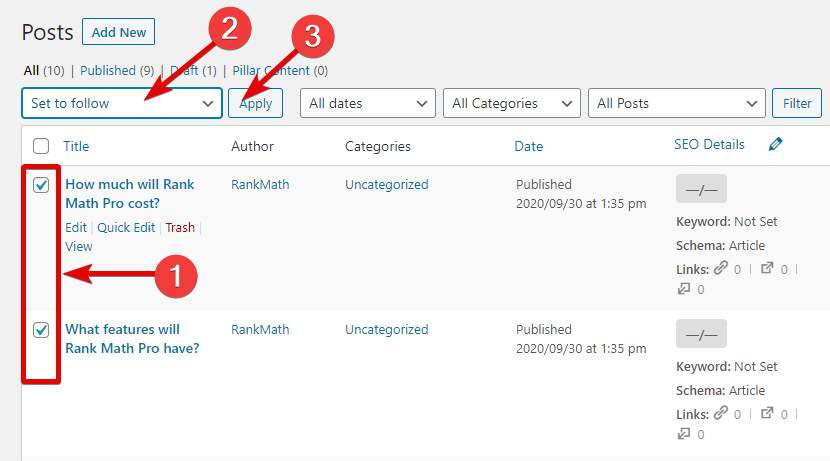
You should see a success notification on the screen, and the posts’ robots meta will be updated.

Remove Custom Canonical URL (Pro)
Custom canonicals should only be used on posts where you are using copied content from some other page on your or someone else’s website. It tells Google where the original piece of content is and that you are using copying content. This way, they will not penalize you for using copied content and they will “discount” your content and not rank you.
If you have accidentally used the setting or if you no longer wish to have a custom canonical URL on multiple posts, you can use this option to remove the canonical URLs in bulk.
To use this bulk action, filter the posts which you want to remove the custom canonical from, or select the posts manually. Then, select the bulk action, and click Apply.
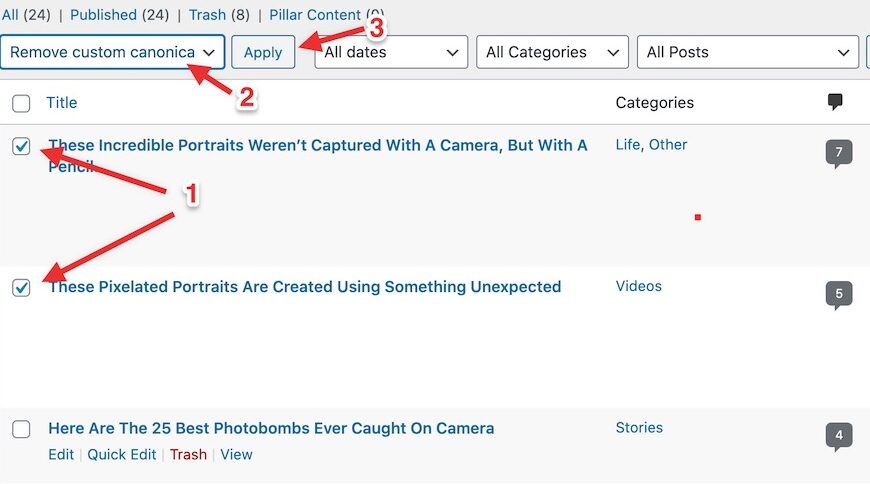
Redirect (Pro)
Redirects are a powerful way to manage your website’s broken links and architecture. It is a simple way to tell Google, “Hey, see that address, don’t go there. Go to this address instead.”
Rank Math has a powerful redirect manager built-in, which lets you create and manage redirects on your website. You’ll find all the settings in Rank Math > Redirections.
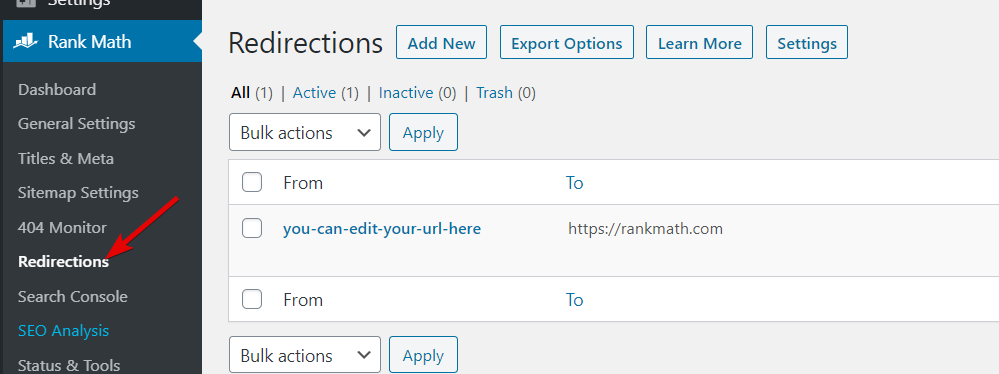
Using the redirect manager, you can redirect multiple pages to a single URL. But, you don’t have the powerful filtering options that Rank Math offers.
To use this bulk action, filter the posts which you want to redirect, or select the posts manually. Then, select the bulk action, and click Apply.
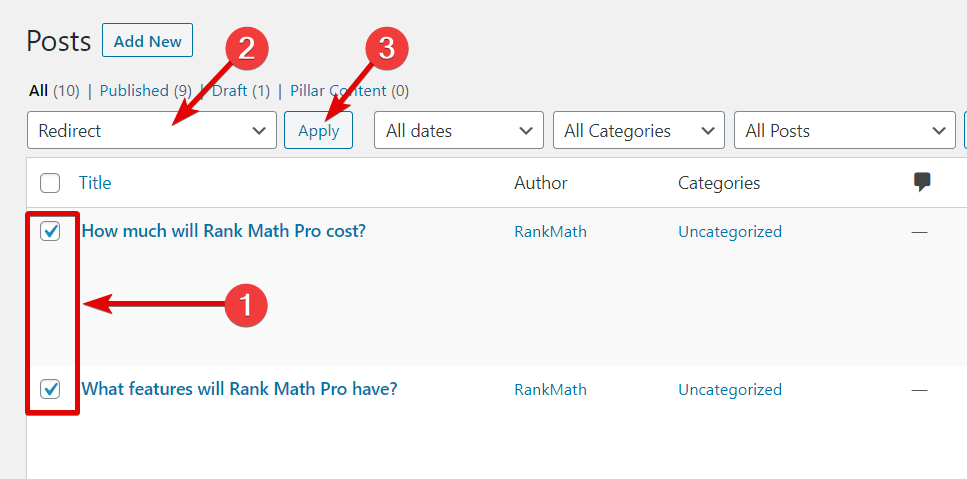
Rank Math will open up the redirect manager, and all the selected posts will be filled in already. You can then select the matching mode, destination URL, redirection type, and the maintenance mode of the redirects. If you’d know what these are, you should read our knowledge base article on working with redirects in Rank Math.
Once you’ve configured the settings to your liking, click the Add Redirection button to save your changes.
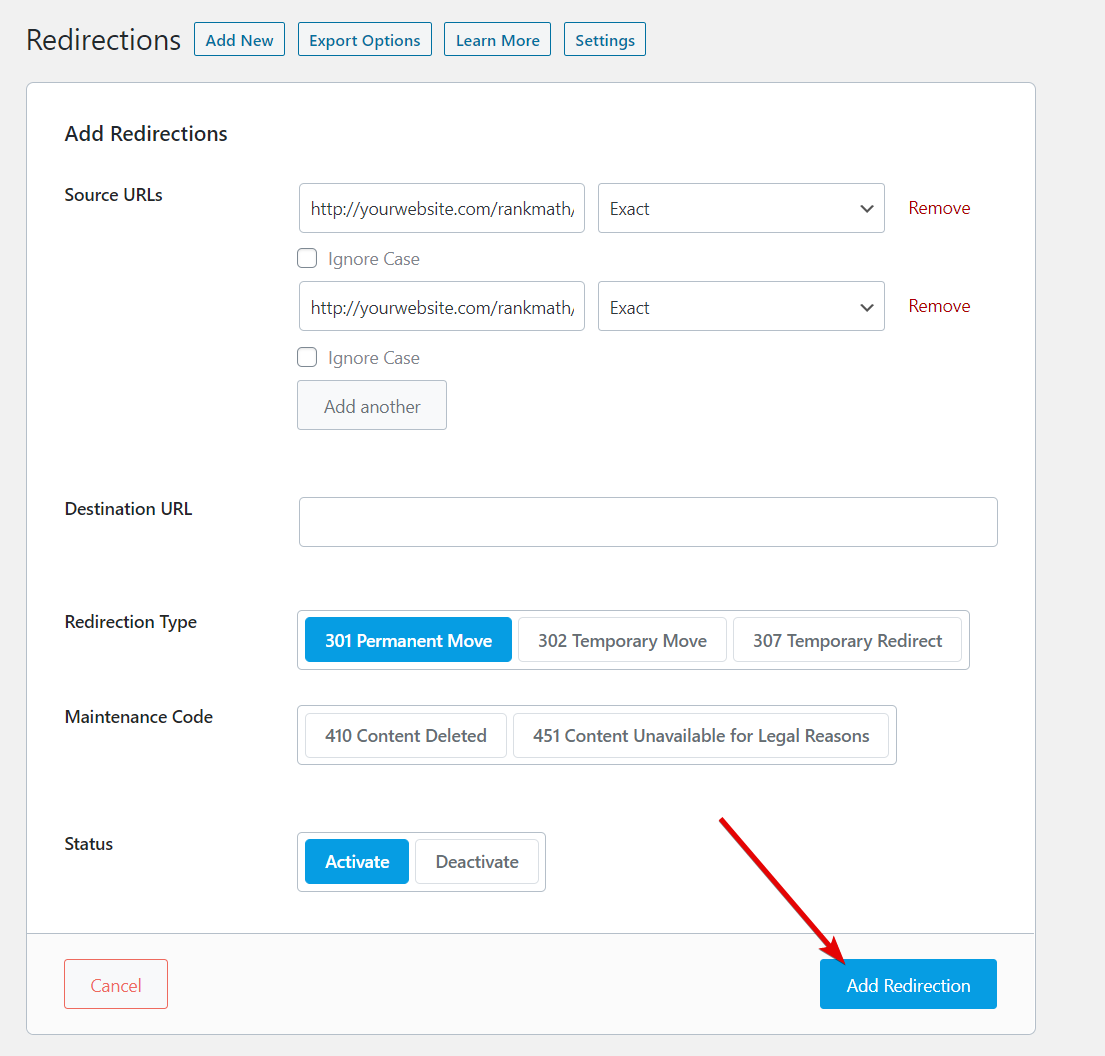
You will see the changes in the redirect manager. You can also edit, delete, or disable the redirect anytime you like.

Remove Redirection (Pro)
The remove redirection bulk action helps in removing redirects from posts. So, it works in the complete opposite way of the action above. These 2 actions combined can be used in powerful ways, and you’ve probably observed a few big websites use similar techniques. Let us give you an example.
Imagine that you’re running a celebrity website and have multiple posts on celebrity “X”. Suddenly, the news breaks that they announced their engagement. Since you’d want to drive all the traffic to the post about their engagement, all you have to do is filter out the post about the celebrity and create a redirect to the new post. This way, all the search and referral traffic would go to the new post. Once the news becomes cold, you can filter the posts again and remove the redirects for those posts.
To use this bulk action, filter or select the posts that you’d like to use this on. Then, select the action from the drop-down menu and click the Apply button.
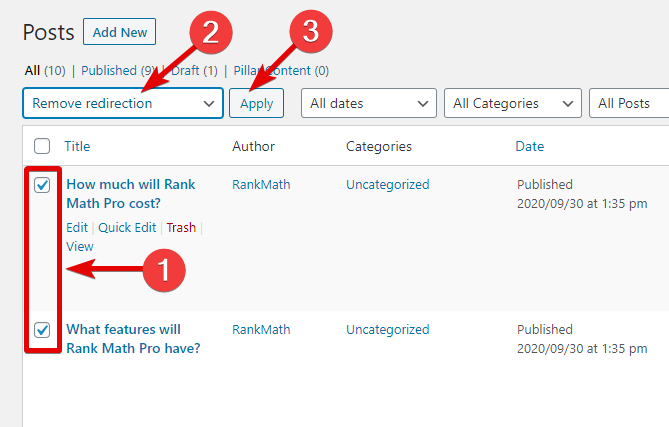
You should see a confirmation message on the screen, and the redirects from those posts will be removed. You can use this bulk action on the posts that do not have redirects, and it will have no effect. You will see the actual number of posts affected in the success message.
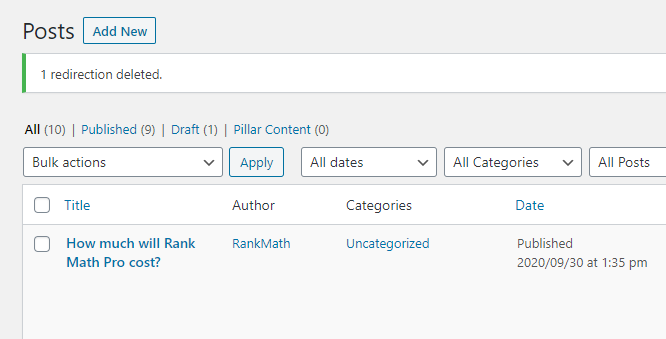
Please note that the redirects will also be removed from the redirect manager, as that was where the redirects were actually stored.
Set Schema: None (Pro)
Rank Math lets you pick a default schema type for your posts, pages, and even custom posts types. You will find this setting inside Rank Math > Titles and Meta.
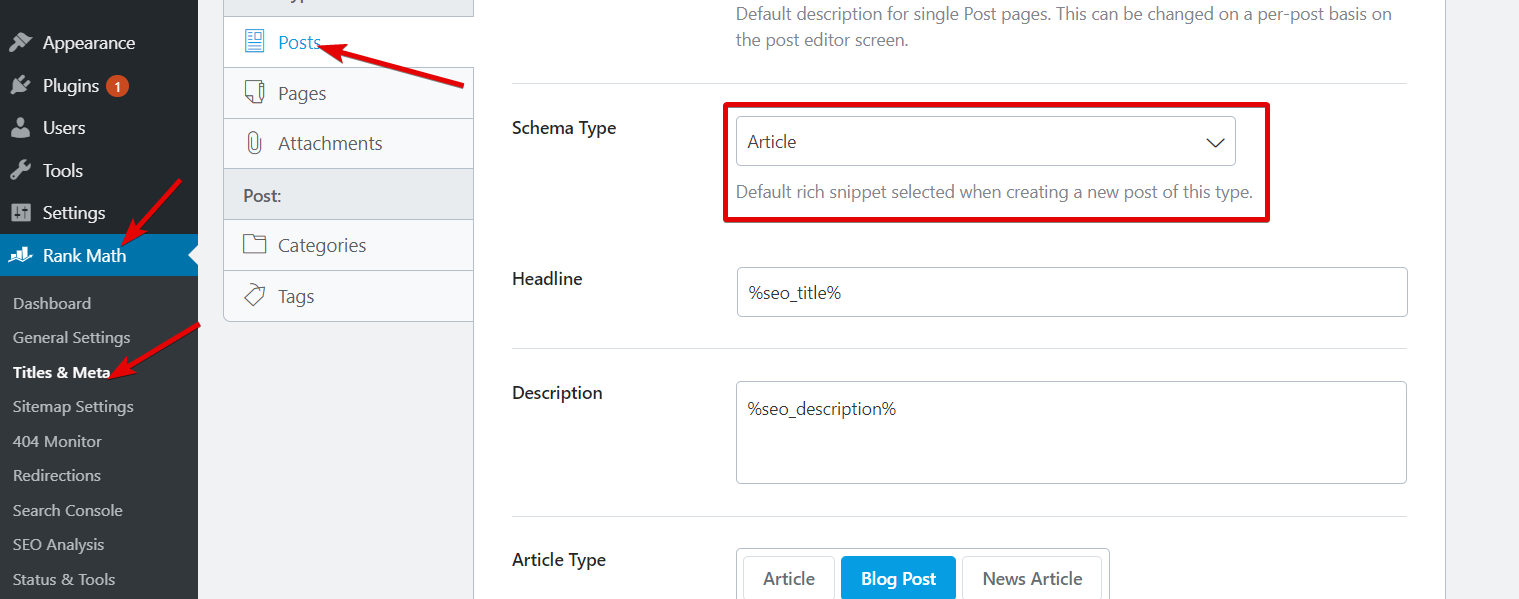
Once you set this global setting, all the posts, pages, or custom post types will automatically get the schema type added to them. You can then customize the schema on a per post basis.
In certain scenarios, there is a need to remove the schema from the page, and that process has to be performed manually, unless you use this bulk action, of course!
By using this bulk action, you can remove the schema from all your posts, pages, and custom post types in a single click. To use it, filter and select or manually select the posts you want to remove the schema from. Then select the bulk action from the drop-down menu and click the Apply button.
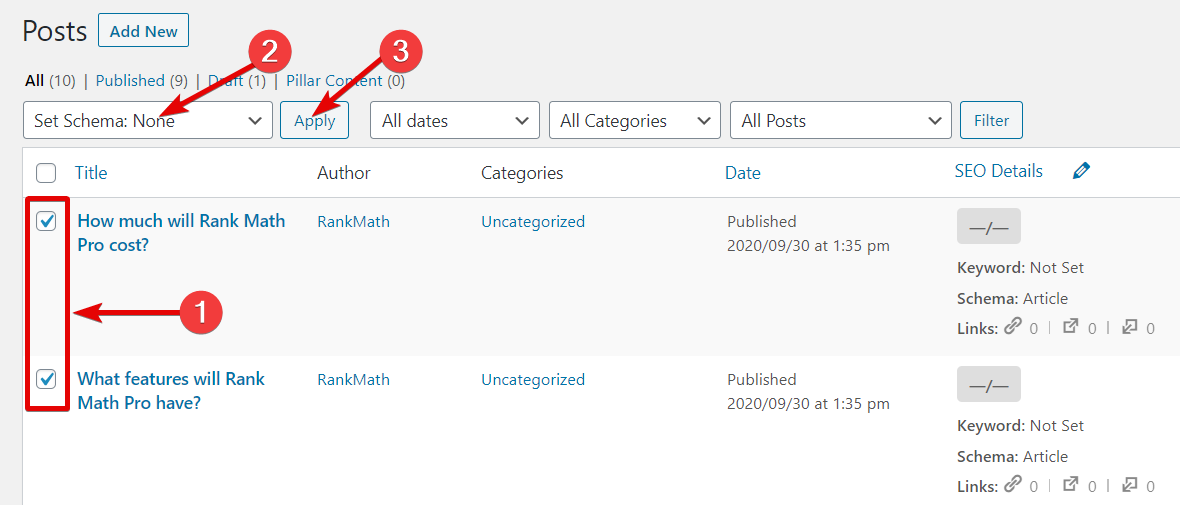
The page will refresh, and you should see the following success message on the screen.
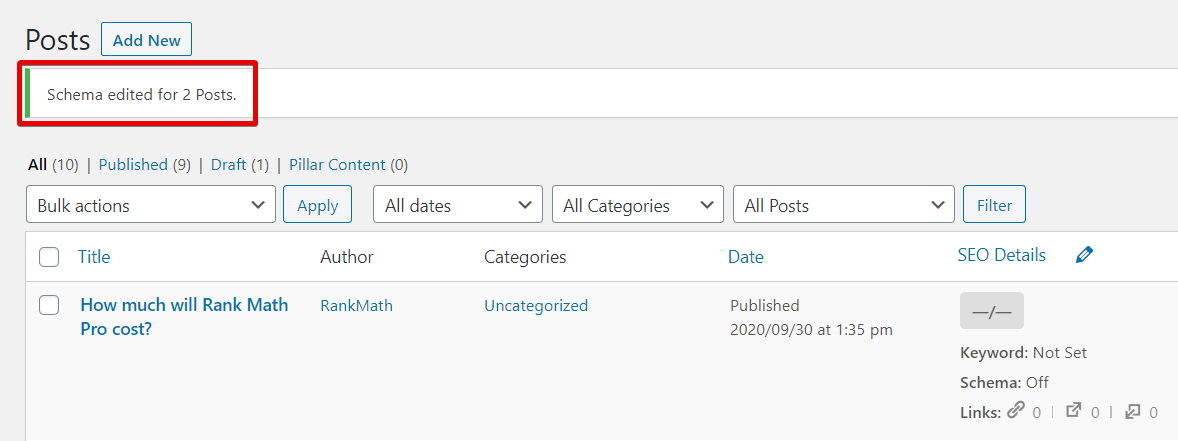
And if we check the schema for any of the posts we used the bulk actions on, you’ll see that they have no schema added.
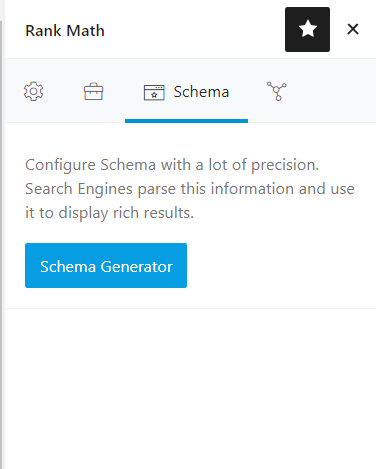
Set Schema: Post Type Default (Pro)
This bulk action helps you assign the default schema to all your posts type in a few steps. When you set up a global schema for a post type, the schema is automatically applied to them. But, if you have applied schema manually to many of your posts, this bulk action, combined with the bulk action above, can help you apply the correct schema correctly. You can use the Set Schema: None to remove the current schema applied to those pages, then use this action to apply the default schema to them.
To use this bulk action, select or filter the posts you want to use it on. Then, select the bulk action from the drop-down menu, and click the Apply button.
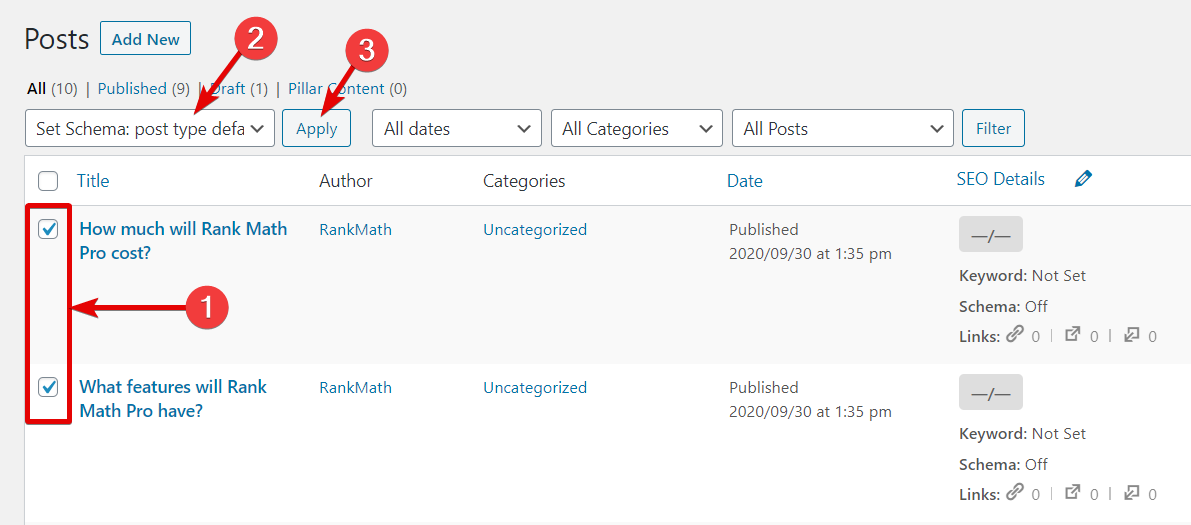
The page will refresh, and you will see a success notice on the screen. You will also notice the schema type applied to the posts.
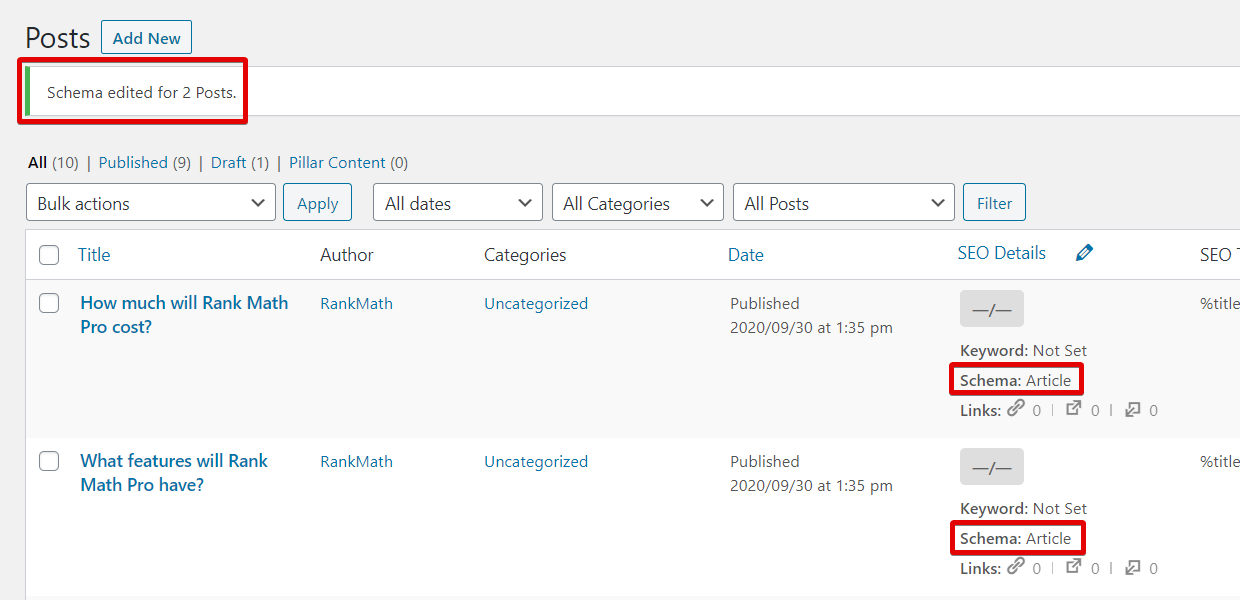
Quick Edits
Many times you might want to make changes to your posts that the bulk actions cannot provide. For example, you cannot change or add focus keywords to multiple posts with bulk actions.
For these tasks, we also built quick actions in Rank Math. They provide a fresh new way to optimize posts and accomplish repetitive tasks, which will take much longer if done in the traditional manner.
To utilize the quick edit option, we will first enable all the fields in the post area. To do that, click the Screen Options button on the top right of the page, and enable all the SEO related fields there. You could enable all the fields, but the page becomes crowded in most cases.

Once enabled, the interface should look something like this.

Now, all the fields in this section do not support quick editing features; we already mentioned that. But which ones do support it? It is simple to see that just by looking at the page. All the fields that have the pencil icon next to it are compatible with quick editing.

Let us look at all the different options and see what we can achieve with quick actions.
Quick Edit SEO Details
The focus keyword is one of the most useful features Rank Math offers. By adding what keywords you’re trying to rank for, Rank Math can give you specific suggestions for optimizing and ranking your post in the search engines. But, when you install Rank Math on a website that already has a lot of content, adding the focus keywords to all those posts can take a long time.
We made the process somewhat easy by letting you filter the post types that have no keywords set, but adding the focus keywords would still take time. With this quick edit feature, that problem goes away. By using this quick edit feature, you’ll be able to add focus keywords to your posts in a fraction of the time. Here is how you use it.
First, filter the posts you want to edit or add the keywords for. Then, click the pencil icon next to the SEO Details.
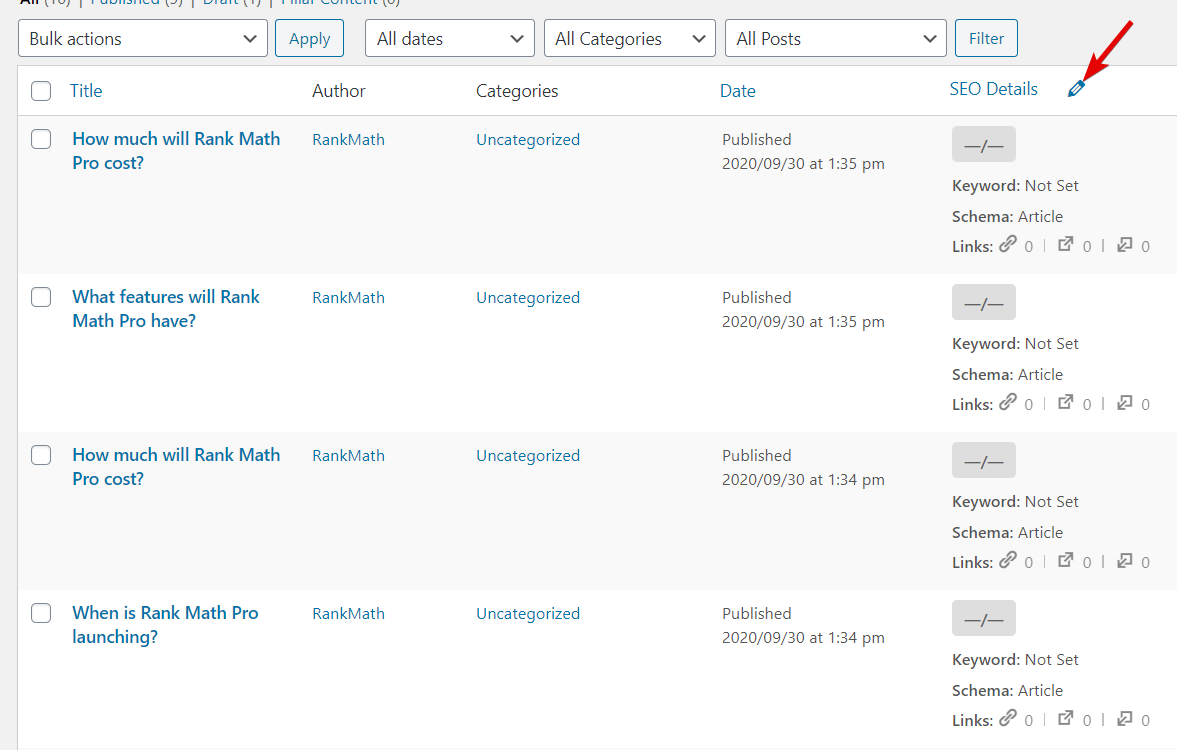
And the fields will become editable. The posts that did not have a focus keyword set will show a blank text field, and the posts with a focus keyword set will show their existing focus keywords.
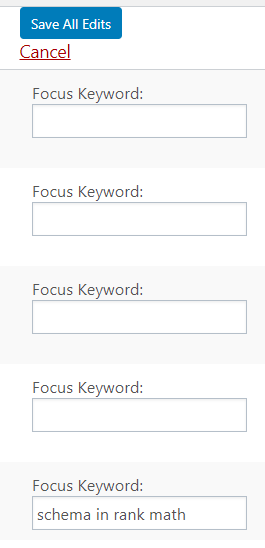
Now, all you have to do is enter the focus keywords for the posts. As you make changes, you’ll have the option to save changes to individual post’s focus keywords,
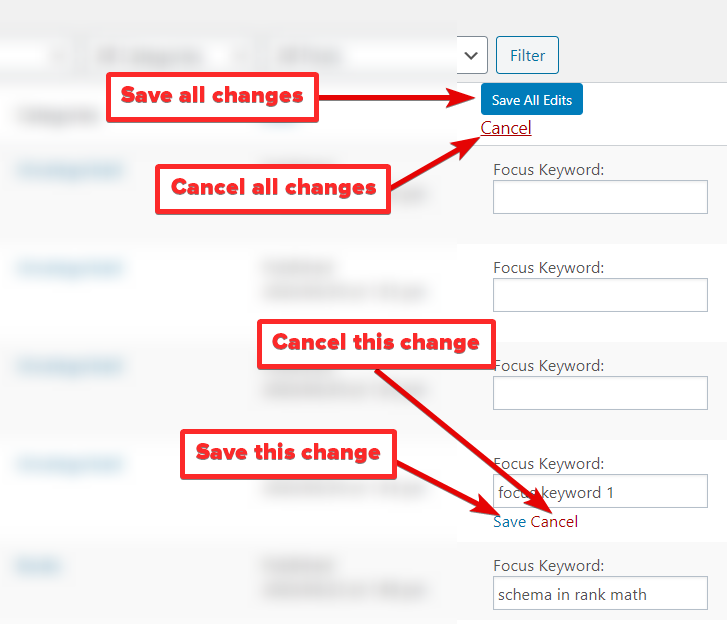
How Focus Keywords Work with Quick Edits
You’re probably familiar that Rank Math lets you add up to 5 focus keywords to each post type (unlimited with a filter). Since you can edit, add, or delete the focus keywords from the post or the quick actions, it is important to understand how both of them work together. Let us take an example.
Let us take a post and set the following focus keywords to the post. “A”,” B”,” C”,” D”,” E”.
When you check out the post on the All Posts page, you will see only the first focus keyword, which is expected behavior.

Now, with the quick actions to update the focus keywords, you will be able to do the following.
- Edit the primary focus keywords
- Add new secondary focus keywords
Yes, you cannot edit secondary focus keywords from the quick actions, only add them.
So, if we were to use the quick actions and change the focus keywords to “1”,” 2″,” 3″,” 4″,” 5″, then these keywords would be added to the list of focus keywords.

Here is where it gets tricky. Rank Math supports 5 focus keywords per post, but that limit is not set in stone. In fact, you can change it 10,20 or an unlimited number of keywords if you prefer. So, if the focus keyword limit is set to 5, here is what will happen when we save the focus keywords from the quick actions.
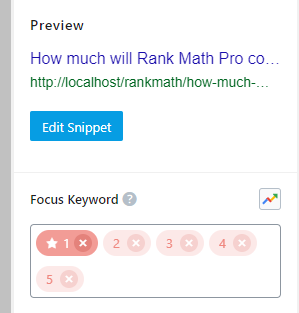
As you can see, all the focus keywords were replaced by the focus keywords set with quick actions.
But, if the focus keywords limit was not set to 5, this is what happened.
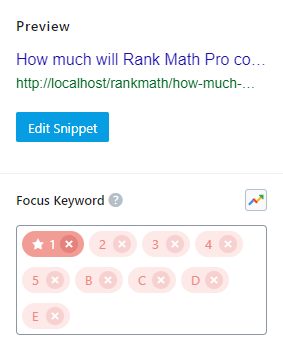
The existing primary focus keyword, “A”, was replaced, and the rest of the focus keywords were added to the list. Make sure to keep these differences in mind when working with quick actions on focus keywords.
Quick Edit SEO Title
The SEO title is one of the most important things that you should optimize as it is one of the key factors on how search engines rank and understand your content.
Rank Math has tools to help you optimize your SEO title in the most effective way possible. You can set up global templates for the SEO title using variables that creates optimized titles for all your post types. You can also override the global template on a per-post basis for complete control.
The quick edit option for the SEO title takes this a step further. Combined with the powerful filtering options, you can quickly filter the posts that you want to update the SEO title for, then use the quick actions to update all of them in a single swoop. Let us show you how it works.
First, we need to filter the posts to the ones that we want to edit. For this demonstration, we will leave the default view in place. Next, we will click the pencil icon next to the SEO Title heading to enter edit mode.
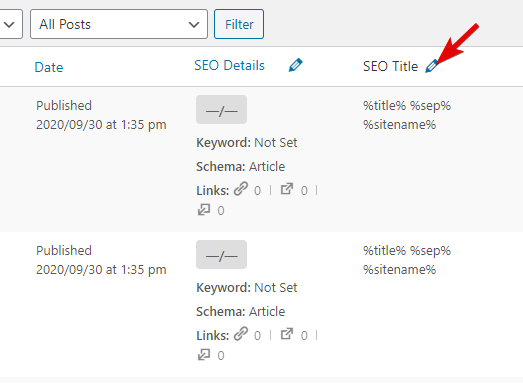
Upon clicking the icon, the SEO Title fields will become editable for all posts in the view. You can then edit the SEO Title for any of the posts. Once you make changes, you will have the options of saving or canceling all changes or save or cancel the change to individual titles.
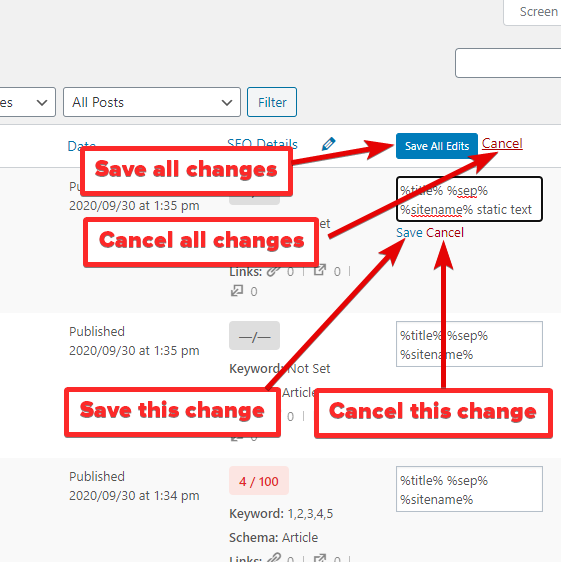
To make the changes, you can use any of the supported variables, plain text, or a combination of them.
Quick Edit SEO Description
The quick edit SEO Description option lets you quickly edit the SEO descriptions for multiple posts. To use it, click the pencil icon next to the SEO description field.

And you’ll see that all the SEO description fields become editable.
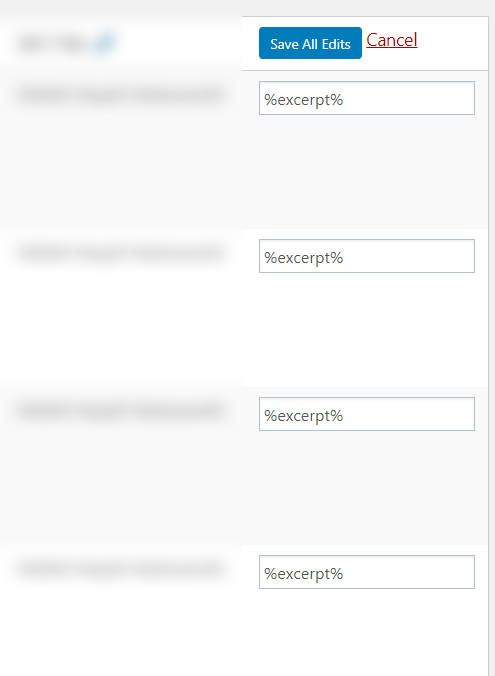
The fields will contain their current values, which may be custom values that you’ve set or global values. You can then edit the fields as you prefer by using variables, text, or a combination of both. Once you’ve made the changes, you have the option of saving the changes for individual SEO descriptions or saving all the changes.
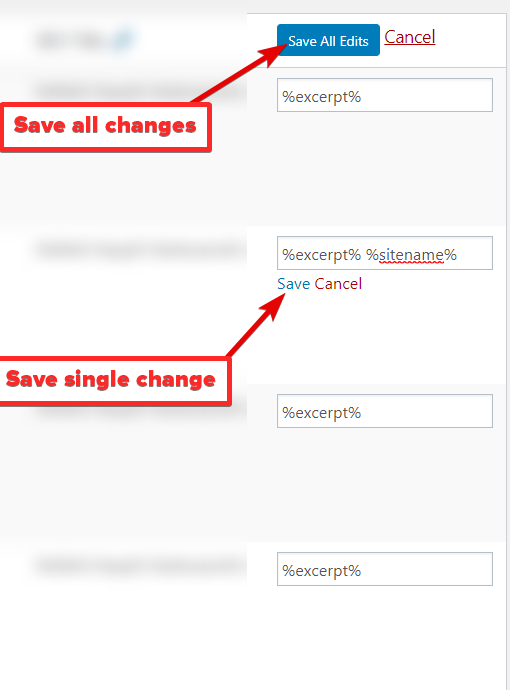
Advance Quick Edit Options
We have extended the core Quick Edit option that comes with WordPress and made it more extensive and advanced. With these options we offer in the Quick Edit section, you can:
- Change the SEO Meta Title and Description Template on Multiple posts/pages/products/CPTs at once
- Update the robots meta tag of Multiple posts/pages/products/CPTs to Index, No Index, No Follow, No Archive, No Image Index, etc..
- Choose a primary focus keyword for multiple posts/pages/products/CPTs at once
- Update the canonical URL of multiple posts/pages/products/CPTs at once
- Choose a primary category for multiple posts/pages/products/CPTs at once
- Or, you can choose a pre-made template to auto-select pre-built options for all of the above

Each of these options and what they do on individual posts has already been covered in the Advanced Meta tab section of our KB.
Working With WooCommerce and Other Custom Post Types
Till now, we’ve explained the filtering, bulk actions, and quick actions only for posts. But, many websites don’t use only posts. They use pages and custom posts as well. Some examples of custom posts would be forums, topics, replies, products, downloads, etc. These custom posts can be created by plugins such as WooCoommerce, Easy Digital Downloads, BuddyPress, and other products. You can even create your own custom post types by using plugins or by adding some code to your website.
We are pleased to tell you that most of the features that we discussed in this article are supported for all pages and custom post types. Here are a couple of screenshots from a few popular plugins. Here is one with WooCommerce.
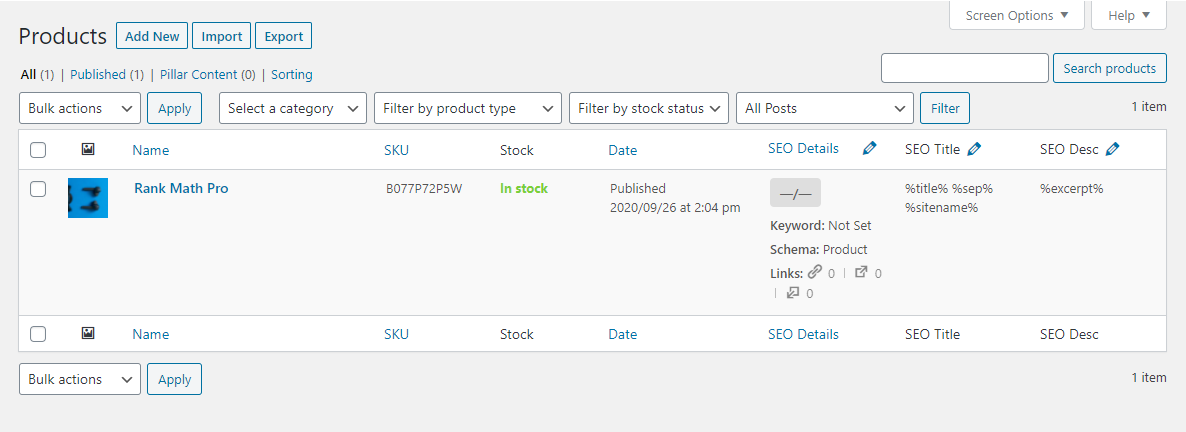
And here is one with Easy Digital Downloads.
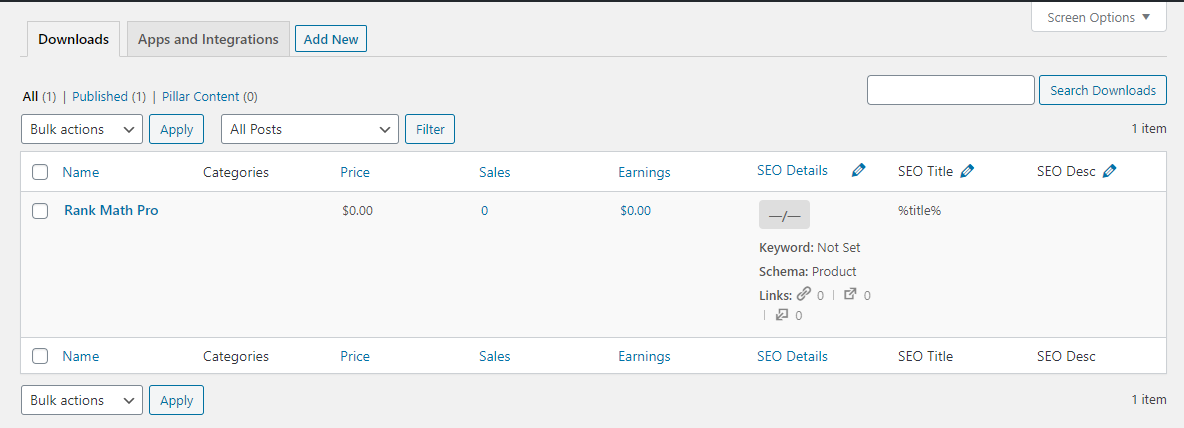
As you can see, you can use filters and quick action in both cases. Currently, bulk actions are not supported for custom post types, but we hope to introduce them very soon.
Using Filters, Bulk Actions, and Quick Actions Together
While the filters, bulk actions, and quick actions are powerful features, the true value of these features only realized when you start using them together. Once you master that skill, you will be able to make optimizations to your website faster than ever, and your competitors will be left wondering how you’re leaving them in the dust.
While there are hundreds of scenarios that you use these features for, here are some practical scenarios that we want to highlight to give you some food for thought.
- Filter all the posts that don’t have focus keywords set and use quick actions to set them quickly
- Filter all posts from a category that were redirected, then remove their redirects with a bulk action
- Quickly filter posts that were updated recently, then update their focus keywords
- If you update your global SEO settings, quickly filter posts that have custom titles or descriptions set and update them
- Quickly redirect all posts from a particular category to a specific post
- Find all orphaned posts and add internal links to those posts
- Find all posts with a specific schema type and add another schema type to them quickly
And many more.
These features are infinitely powerful, and we would highly recommend that you invest some time in getting to know these features better. Once you understand their power and start utilizing them, your views on how to manage your website will surely change.
Conclusion
With the new filtering and bulk editing options, Rank Math has solved one of the biggest pain points in managing and optimizing posts on your website. With these amazing updates, the already amazing Rank Math is more powerful than ever.
Now, it is up to you! Start using these features and making big leaps in how you optimize your website and gain traffic. If you have any questions or doubts, the Rank Math forum is just a click away. If you have some feedback you’d like to share, the Rank Math Facebook Group is another great place to hang out.









16 Comments
Great post. I'm going through some of these issues as well..
ReplyDeleteasmr 0mniartist
I'm really enjoying the design and layout of your site. It's a very easy on the eyes which
ReplyDeletemakes it much more enjoyable for me to come here and visit more often.
Did you hire out a developer to create your theme? Excellent work!
asmr 0mniartist
Hey There. I found your blog using msn. This is a very well
ReplyDeletewritten article. I'll make sure to bookmark it and return to
read more of your useful information. Thanks for the post.
I'll definitely comeback. 0mniartist asmr
Wow that was strange. I just wrote an extremely long comment but after I clicked
ReplyDeletesubmit my comment didn't show up. Grrrr... well I'm not writing all that over again. Anyways, just wanted
to say excellent blog! 0mniartist asmr
Hmm it seems like your site ate my first comment (it was
ReplyDeletesuper long) so I guess I'll just sum it up what I had written and say,
I'm thoroughly enjoying your blog. I too am an aspiring blog writer but I'm still new to the whole thing.
Do you have any tips for inexperienced blog writers? I'd really
appreciate it.
Contact us: info@deworldinshights.com
ReplyDeleteI seriously love your site.. Very nice colors & theme.
ReplyDeleteDid you create this amazing site yourself? Please
reply back as I'm trying to create my very own site and
would like to learn where you got this from or just what the theme is named.
Appreciate it!
Link exchange is nothing else but it is simply placing the
ReplyDeleteother person's web site link on your page at proper place
and other person will also do same in support of you.
My brother suggested I would possibly like this website. He was once entirely right.
ReplyDeleteThis post truly made my day. You can not consider simply how much time I had spent for this info!
Thanks!
Hello would you mind sharing which blog platform
ReplyDeleteyou're using? I'm planning to start my own blog soon but I'm having a tough time choosing between BlogEngine/Wordpress/B2evolution and Drupal.
The reason I ask is because your design and style seems
different then most blogs and I'm looking for something unique.
P.S Apologies for being off-topic but I had to ask!
Contact us: info@deworldinshights.com
ReplyDeleteThis site truly has all of the info I wanted about this subject and didn't know who to ask.
ReplyDeleteYou have made some really good points there. I checked on the net for more info about the issue and found most
ReplyDeleteindividuals will go along with your views on this site.
scoliosis
ReplyDeleteBecause the admin of this web site is working, no hesitation very shortly it will be renowned, due to its quality contents.
scoliosis
I am genuinely grateful to the owner of this site who has shared this wonderful paragraph
ReplyDeleteat at this time.
Great work! This is the type of info that are meant to be shared around the web.
ReplyDeleteShame on Google for no longer positioning this post
upper! Come on over and talk over with my website .
Thank you =)